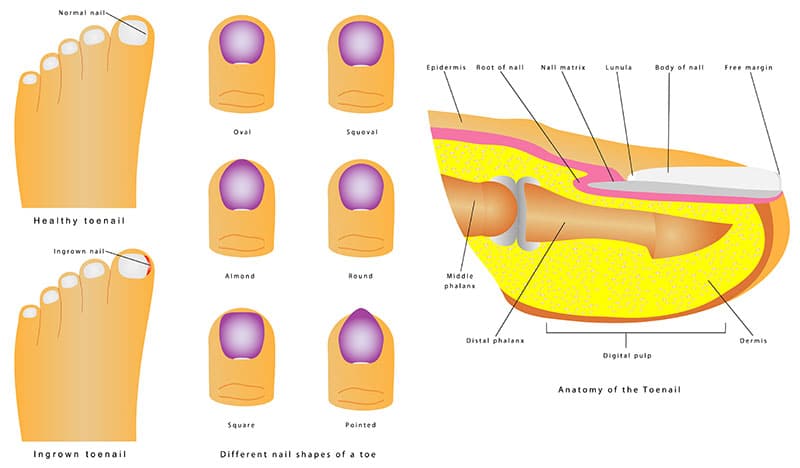What causes an ingrown toenail – Symptoms and Signs

INGROWN TOENAILS
The pressure obtained from the ingrowth of the edge of the nail into the toe skin causes ingrown toenails. Inflammation is produced once the edge of the nails breaks through the toe skin. It may initially seem to be a minor discomfort but may gradually progress into an infection in the skin or become a reoccurring issue. Ingrown toenails are affected mostly on the large toes and medically this is referred to as onychocryptosis.
Facts
- An ingrown toenail is a condition commonly seen in the large toenail.
- Toe injuries and improper shoe gear are associated with ingrown toenails.
- Athletes usually suffer from ingrown toenails.
- If not treated properly, this can occur very frequently.
- Conservative treatments including elevation, good foot hygiene, and soaks are done for the cure. It is not necessary to go for a medical treatment always.
- In the presence of an infection, oral antibiotics are used as a treatment. A minor surgery in the toenail might be required in some conditions.
Causes-
Improper trimming of the toenail is one of the main causes of this problem. This includes hereditary or an inherited condition and improper shoe fitting. Other common causes are nail picking and injury by aggressive pedicures.
Risk factors-
The following are some of the factors in which the people are prone to ingrown toenails.
- If the shoe gear is either too large or small for your toes, then this problem can arise.
- Athletics, tennis, basketball and soccer are the sports games in which the players usually experience ingrown toenails.
- Repetitive trauma or pressure to the feet.
- Abnormal gait
- Poor foot hygiene.
- Congenital toenail deformity.
- Toe or foot deformities such as hammertoes and bunions.
- Diabetes
- Obesity
- Abnormal long toes
- Arthritis
- Fungal infection in the nails
- Hyperhidrosis which means the sweating of the feet excessively.
- Soft or Bony tissue tumours.
Symptoms and Signs-
The symptoms and signs are swelling, pain and redness. Yellowish drainage will be seen sometimes or otherwise if the toenails are infected, pus drainage will be observed. There is a great chance for the ingrown toenails to resolve without any treatment. Persistent, reoccurring, and painful ingrown toenails must be treated by a podiatrist.
Home remedies for ingrown toenails-
A great relief will be given to the person who has ingrown toenails if they follow some of these home remedies.
- 15 to 20 minutes soaking in lukewarm water with one of the several options given will be really helpful: 2 tablespoons Epsom salts, one part vinegar with four parts of water, dilute Clorox bleach or 1/3 teaspoon Clorox in 1 gallon of water.
- Elevate the leg and foot.
- Oral anti-inflammatory medications must be taken.
- Without leaving them too short trim the toenail across the top.
- Roll back the skin which is overgrown at the affected nail and this would allow lifting the toenail up from the skin.
Surgery is only recommended if all the conservative treatments have failed. A matrix ectomy is recommended if the condition is recurrent. The surgery is not very complicated and so the patient does not have to panic.







